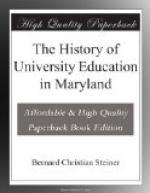hold and instruct them. Those who do nothing
more than simply attend the lectures will at least
have gained the education of continuous interest; it
is something to have one’s attention kept upon
the same subject for three months together. But
it may be assumed that in every such audience there
will be a nucleus of students, by which term we simply
mean persons willing to do some work between one lecture
and another. The lectures are delivered no oftener
than once a week; for the idea is not that the lectures
convey the actual instruction—great part
of which is better obtained from books, but the office
of the lecture is to throw into prominence the salient
points of the study, and rouse the hearers to read,
for themselves. The course of instruction is laid
down in the syllabus—a document of perhaps
thirty or forty pages, sold for a trifling sum; by
referring for details to the pages of books this pamphlet
can be made to serve as a text-book for the whole course,
making the teacher independent in his order of exposition
of any other text-book. The syllabus assists
the general audience in following the lectures without
the distraction of taking notes; and guides the reading
and thinking of the students during the week.
The syllabus contains a set of ‘exercises’
on each lecture. These exercises, unlike examination
questions or ‘quizzes,’ are not tests of
memory, but are intended to train the student to work
for himself; they are thus to be done under the freest
conditions—at home, with full leisure, and
all possible access to books, notes or help from other
persons. The written answers are sent to the
lecturer for marginal comment, and returned by him
at the ‘class.’ This class is a second
meeting for students and others, at which no formal
lecture is given, but there is free talk on points
suggested to the teacher by the exercises he has received:
the usual experience is that it is more interesting
than the lecture. This weekly routine of lecture,
syllabus-reading, exercise and class goes on for a
period of twelve weeks. There is then an ‘examination’
in the work of the course held for students who desire
to take it. Certificates are given by the university,
but it is an important arrangement that these certificates
are awarded jointly on the result of the weekly
exercises and the final examination.
The subjects treated have been determined by the demand. Literature stands at the head in popularity, history with economy is but little behind. All the physical sciences have been freely asked for. Art constitutes a department of work; but it is art-appreciation, not art-production; the movement has no function to train artists, but to make audiences and visitors to art-galleries more intelligent. It will be observed that the great study known as ‘Classics’ is not mentioned in this list. But it is an instructive fact that a considerable number of the courses in literature have been on subjects of Greek and Latin




